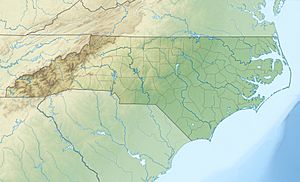Turnbull Creek (Cape Fear River tributary) facts for kids
Quick facts for kids Turnbull Creek |
|
|---|---|
|
Location of Turnbull Creek mouth
|
|
| Other name(s) | Tributary to Cape Fear River |
| Country | United States |
| State | North Carolina |
| County | Bladen Cumberland |
| Physical characteristics | |
| Main source | between Bushy Lake and Rollins Pond about 5 miles west-southwest of Roseboro, North Carolina 110 ft (34 m) 34°54′19″N 078°41′10″W / 34.90528°N 78.68611°W |
| River mouth | Cape Fear River about 1.5 miles east of Elizabethtown, North Carolina 23 ft (7.0 m) 34°37′29″N 078°33′24″W / 34.62472°N 78.55667°W |
| Length | 27.78 mi (44.71 km) |
| Basin features | |
| Progression | southeast |
| River system | Cape Fear River |
| Basin size | 88.27 square miles (228.6 km2) |
| Tributaries |
|
| Bridges | Turnbull Road, Squatting Bear Drive, Avery Road, Walter West Road, Braxton Edge Road, NC 242, Lula Long Road, Johnsontown Road, Sweet Home Church Road, Old Hoover Bridge Road, US 701-NC 41 |
Turnbull Creek is a stream in North Carolina, USA. It is about 27.78 miles (44.71 km) long. This creek is a "tributary," which means it's a smaller stream that flows into a larger river. Turnbull Creek flows into the Cape Fear River in Bladen County, North Carolina.
Where Turnbull Creek Flows
Turnbull Creek starts in Cumberland County, North Carolina. It begins in an area between two ponds called Bushy Lake and Rollins Pond. This spot is about 5 miles east of a town called Roseboro, North Carolina.
From there, Turnbull Creek flows towards the southeast. It travels into Bladen County, North Carolina. Finally, it joins the larger Cape Fear River. This meeting point is about 1.5 miles east of Elizabethtown, North Carolina.
The Land Around Turnbull Creek
The area that Turnbull Creek drains is called its "watershed." This watershed covers about 88.27 square miles (228.6 km²). A watershed is like a giant funnel. All the rain that falls in this area eventually flows into Turnbull Creek.
This region gets a good amount of rain each year, about 49.1 inches (125 cm). A big part of the watershed, about 23%, is covered by forests. These forests help keep the water clean and provide homes for many animals.



